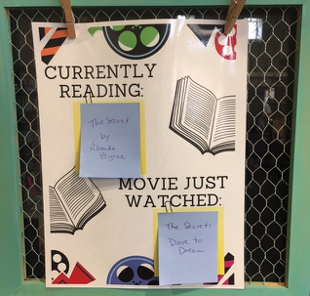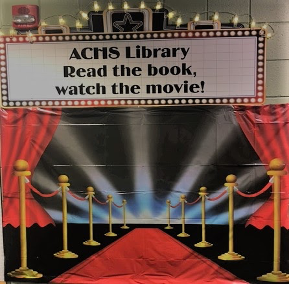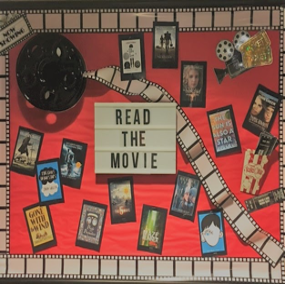|
By Deborah Eades  The Andover Central High School Christmas Book Exchange The Andover Central High School Christmas Book Exchange We’ve all heard the claims and read the reports. Reading is good for you. As English teachers, we witness first-hand the increase in empathy, understanding, perspective, and--oh yes-- test scores that accompany reading. Sadly, however, as students move through from primary to secondary school, many of them stop reading for pleasure. Let’s face it, many of them stop reading even for school. One of the best ways to learn a foreign language is immersion study. People sign up to live and study in a foreign country, and they learn the language faster. Living in the culture of the language shifts the brain into turbo boost. The scholars begin thinking in a new way that facilitates the acquisition of language. A similar experience can happen when schools create a culture of reading. I noticed this for the first time when I moved to a new district. From what I could tell, nearly all the staff at my new school were readers. Lunchtime conversation often centered around someone’s latest book haul. A book shelf in the teacher’s lounge invited us to take a book and leave a book. Teachers set their email signatures to note their current reads. Some staff members met every summer for a long-standing book club. Even staff Christmas parties culminated in a gift exchange of books. Reading was everywhere, and because of this, students were exposed to reading as not just a classroom requirement, but as a passion. When students are immersed in a positive reading culture, it makes a difference. They carry their personal reading material with them and turn to it rather than cell phones during down time. They discuss plot and character and tone like they’re bantering about the latest Tik-Tok craze. They ask teachers and librarians for recommendations and offer recommendations to their peers. When students read for pleasure, they come to those complex texts we force on them with minds that are more open and willing. Because I believe in the benefits that reading can have on students, I wanted to share some different ways to help engage your students with texts they love. Listed below are three ways to create a culture of reading in your school. Book/Movie Connection We already do this in class, don’t we? We read the book, and at some time during the unit, we show at least parts of the movie, if not the whole thing. However, sometimes we are guilty of sending mixed messages. We chastise students for watching the movie or teachers from other departments for showing the movie before we study the text in class. If we believe that a movie version can offer insight and clarity, why not fully embrace it? In fact, a colleague and I recently discussed this very idea. You can read our conclusions on the value of movies in the classroom here. Our librarian, Heather Hawkins (who blogged for KATE about Skype), welcomed students back this year with a giant wall display advertising all the book/movie combos our school library has in stock. Those movies had been hidden away in a back room, accessible only by teachers for years. Why? What’s the point of restricting student access to book-inspired movies? By embracing the book/movie connection, she has offered students an welcoming doorway back to reading for pleasure. The message is if you liked the movie, you’ll love the book. We have both right here waiting just for you.  Show and Tell Shingles You know how businessmen, lawyers, and barbers hang out a “shingle” to advertise their services? Staff members can utilize this same technique by hanging a shingle to advertise their current reading interests. Imagine the power of students seeing a “Currently Reading” sign on nearly every classroom they enter. The message amplifies when the shingles showcase current reads of office staff and lunch ladies and coaches, too. Students get it pretty quickly. Adults at their school value reading, and not just the English teachers. Sharing your reads with the student body creates other connections, too. Students know who the avid readers are, but they also know which teachers take forever to read a book. Slow readers start to realize it’s okay to not be a fast and furious reader, as long as they are reading. Additionally, students notice the topic trends. When a sci-fi fan student sees that his/her math teacher voraciously reads Marie Lu books, the door opens for bonding beyond the curriculum. To get your entire staff on board, make it easy for them. Print and distribute simple “Currently Reading” signs. Tell staff you are trying an experiment, and you want to see how many kids notice the signs. Some teachers might be more willing to help with an experiment than to be told they have to hang a sign. You know how we can be, guys. If a math teacher told me to hang a sign revealing how I use math each day, I might be hesitant about possible judgment. However, sometimes students need to see teachers taking a chance in order to be willing to take a chance, too. So, print the signs, ask for the support, and when Math asks back, return the favor. Facilitate Reading for Fun Some of us already do this, but it’s good to remind ourselves how important it is to facilitate reading for fun, especially in times of change. A few years ago, our ELA department decided to start every class period with ten minutes of daily reading. We expected our students to have personal reading material with them, preferably hard copies. The reading material could be a novel, a graphic novel, a magazine, a book of poetry, even a cookbook if that’s what a student liked to read. We stocked our rooms to create easy access and ward off I-forgot-my-book excuses. Immediately, students were confused. Did they have to take notes? Would there be a test? Should they turn in a reading log? Could they switch out a book if they didn’t like the one they chose? It took a while for them to realize they were reading for fun. Period. That’s it. It wasn’t long before students appreciated this reading time. They protected this time, and reminded teachers when we forgot. Over time, some of us have tweaked the practice. Some teachers have students read for twenty minutes twice a week instead of ten minutes daily. One switched to using one whole class period once a week. I change it up if we are currently reading a novel as a class. We read that book instead and then go back to fun reading after. Some teachers moved to requiring students to at least share out casually a quick summary and recommendation, which the students loved, by the way. The approach might have morphed, but results were steady. Students appreciated the opportunity to read what they wanted, so they were less resistant to required reading. The positive effect of personal reading time outweighed the instructional minutes sacrificed. If you find that your students aren’t utilizing this time as much as you would like, here is one tip to increase the effectiveness of this practice--read with your students. Resist the urge to answer emails or grade a couple essays. Students need to see you model this behavior. One thing we all know for sure is that preaching to students that they should read doesn’t work. It amounts to one more adult “shoulding” on them. Modeling a passion and creating a culture of reading does work. It might be slow going at first. Teenagers sometimes equate new ideas with weird ideas. They might associate reading with nerdiness. As much as English teachers don’t mind being nerds, not all students agree. When reading becomes the norm, gradually, a culture of reading will emerge and students who read for pleasure will emerge from it. The bonus effect will be higher reading scores, of course, but more importantly a more curious, understanding, and empathetic generation. In academia, there’s not much else that can change a child’s world more than reading. While these three suggestions are a great way to initiate a reading culture in your classroom, there are infinite other possibilities as well. Comment below some other ways you encourage reading outside the curriculum. What are some of your favorite reads? Don’t forget to check out KATE Blog Goodreads for great recommendations or join our join or book clubs for KATE members.  About the Author Deborah McNemee teaches at Andover Central High School where a culture of reading is alive and well. She creates a culture of reading with her students by annually hosting a project based event in partnership with Big Read Wichita. She facilitates a writing culture through encouraging involvement with the NaNowriMo Young Writers Program and submitting student work to Voices of Kansas. Her favorite books to read outside of school are classics. Check out her blog about keeping classics relevant for kids at www.KeepingClassics.com.
0 Comments
Your comment will be posted after it is approved.
Leave a Reply. |
Message from the EditorWelcome! We're glad you are here! Archives
March 2024
Categories
All
|


 RSS Feed
RSS Feed